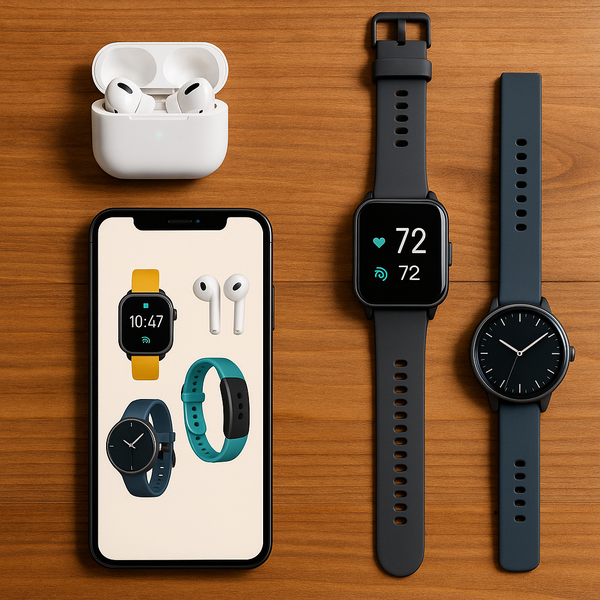
Choosing the perfect wearable technology can feel overwhelming with the vast array of options available today. These devices, ranging from smartwatches and fitness trackers to AR glasses and hearables, promise to enhance our lives in numerous ways, from monitoring health and fitness to providing convenient access to information and entertainment right at our fingertips. Making the right choice requires understanding your needs and what each type of device offers.
Understanding Different Types of Wearable Tech
Wearable technology encompasses a broad category of electronic devices designed to be worn on the body. The most common types include smartwatches, fitness trackers, and hearables (smart headphones or earbuds). Each serves different primary purposes, although many devices now offer overlapping functionalities. Smartwatches are often seen as extensions of our smartphones, allowing us to receive notifications, make calls, run apps, and sometimes track basic fitness metrics directly from our wrist. They typically have color touchscreens and offer a wide range of features.
Smartwatches: More Than Just a Watch
Smartwatches are perhaps the most visible segment of the wearable market. Brands like Apple, Samsung, and Google (with Wear OS) dominate this space, offering devices that integrate deeply with their respective mobile ecosystems. When choosing a smartwatch, consider compatibility with your existing smartphone – an Apple Watch works best with an iPhone, while Wear OS devices pair well with Android phones. Battery life is another crucial factor; some smartwatches need daily charging, while others can last several days. Features vary widely, from advanced health monitoring like ECG and blood oxygen tracking to built-in GPS for navigation and mobile payment capabilities. Think about what features are essential for your daily routine. Do you need cellular connectivity to stay connected without your phone? Is swim-proofing important? The display type, material quality, and available watch faces also contribute to the user experience and aesthetic appeal.
Fitness Trackers: Your Personal Health Companion
Fitness trackers, such as those made by Fitbit, Garmin, and Xiaomi, are primarily focused on monitoring physical activity and health metrics. They are generally simpler and often more affordable than smartwatches, prioritizing sensors for steps taken, distance covered, calories burned, heart rate, sleep patterns, and sometimes even stress levels or skin temperature. Battery life for fitness trackers is typically much longer than smartwatches, often lasting for a week or more on a single charge. Their design is usually more discreet and lightweight, making them comfortable for continuous wear, including during sleep and exercise. When selecting a fitness tracker, consider the specific activities you want to track. Are you a runner who needs accurate GPS? A swimmer who requires water resistance? Someone focused on improving sleep quality? Pay attention to the companion app's features, as this is where you'll analyze your data, set goals, and track progress.
Hearables: Audio Meets Intelligence
Hearables, including truly wireless earbuds with smart features, are becoming increasingly popular. While their primary function is audio playback or communication, many now incorporate sensors and intelligence. Some hearables offer active noise cancellation, transparency modes, or spatial audio. More advanced models include fitness tracking capabilities, built-in voice assistants, or even real-time translation. For example, some earbuds can track your heart rate or monitor your posture. The focus for hearables is often on audio quality, comfort, secure fit for different activities, and battery life (both for the earbuds and their charging case). Consider how you plan to use them – primarily for music, podcasts, calls, or integrating smart features into your audio experience.
Factors to Consider Before Buying
Beyond the specific type of wearable, several universal factors should influence your decision. First, consider your budget. Wearables range from under $50 for basic fitness bands to several hundred dollars for high-end smartwatches. Second, think about compatibility. Ensure the device works seamlessly with your smartphone and other technology ecosystems you use. Battery life is crucial, especially if you don't want to charge daily. Design and comfort are also important – you'll be wearing this device for extended periods. Look at the build quality, materials, and how it feels on your body. Durability and water resistance are key if you plan to wear it during strenuous activities or in wet environments. Finally, research the companion app and ecosystem. A good app is essential for interpreting data, customizing settings, and getting the most out of your wearable.
Health and Privacy Implications
Choosing wearable tech also involves considering health and privacy. These devices collect significant amounts of personal data, including sensitive health information. Understand how this data is stored, used, and protected by the manufacturer. Review their privacy policy. Additionally, while wearables can provide valuable insights, they are not medical devices (unless explicitly stated and regulated as such) and should not be used for diagnosing or treating health conditions. They are tools for awareness and motivation. Be mindful of screen time and potential distractions from notifications.
Comparing Features and Brands
Once you've narrowed down the type of wearable and considered the key factors, it's time to compare specific models and brands. Read reviews from other users and technology publications. Look at side-by-side comparisons of features, performance, and price. Consider the reputation of the brand for reliability and customer support. Some brands excel in fitness tracking, while others are stronger in smartwatch features or design. Thinking about future-proofing might also be relevant – does the device receive regular software updates? Can accessories like straps or bands be easily replaced?
Selecting the right wearable technology is a personal journey based on your lifestyle, goals, and preferences. By considering the different types available, evaluating key features like battery life and compatibility, and reflecting on how you intend to use the device, you can make an informed decision that leads you to a wearable that truly enhances your daily life and helps you achieve your objectives, whether they relate to health, fitness, communication, or convenience.

